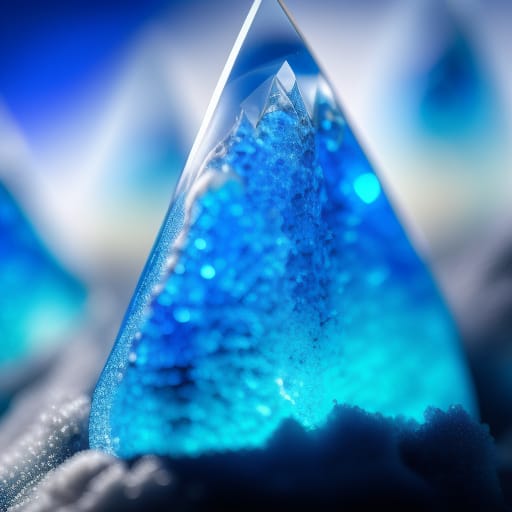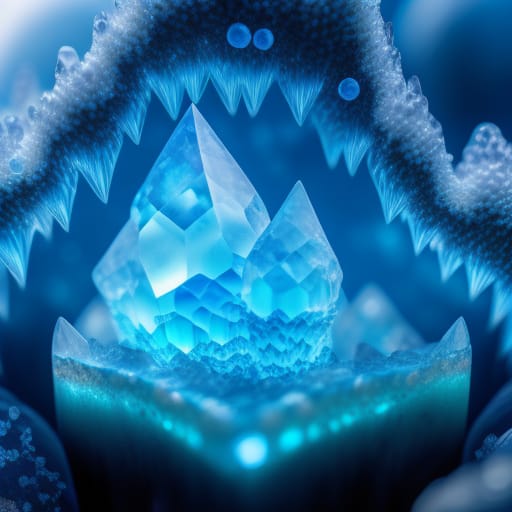Have you ever looked closely at a snowflake and marveled at its unique geometric shape? Or gazed in wonder at a glittering crystal geode, with its awe-inspiring formations? Crystals like these aren’t just beautiful to look at – they can also teach us a great deal about the nature of life on a molecular level.
In this beginner’s guide, we’ll explore the world of crystal growth and structure to understand what crystals are, how they’re formed, and the science behind their seeming “aliveness”. Whether you want to grow your own crystals at home or just learn more about these mesmerizing structures, read on to uncover the basics of crystallography!

What Are Crystals and How Do They Form?
Crystals are solid materials in which the molecules are arranged in an orderly, repeating 3D pattern. This internal arrangement of the molecules is known as the crystal structure or crystal lattice.
The properties of a crystal – such as its shape, hardness, color, and more – are determined by its internal structure. Crystals can form naturally through geological processes, or be synthesized in a laboratory.
There are several ways that crystal growth occurs:
- Solution growth – Crystals grow from a solution containing dissolved minerals. As the solution evaporates, the minerals come out of the solution and bond together in an orderly crystalline structure.
- Vapor growth – Gaseous molecules condense directly into a crystalline solid, without going through a liquid phase.
- Melt growth – Crystals are grown from a molten liquid which is slowly cooled. Atoms arrange themselves into a regular crystal pattern as the melt solidifies.
- Solid growth – Crystals grow larger by direct deposition of molecules onto the existing crystal structure.
Regardless of the method, molecules must come together in a highly organized way for a crystal to form. The molecules arrange themselves to minimize energy, resulting in the repetitive geometrical patterns we associate with crystals.
Crystal Structure and Symmetry
The crystal structure refers to the shape and arrangement of the crystal lattice. There are seven main crystal systems that describe the lattice geometry based on the lengths of the crystallographic axes and the angles between them:
- Cubic
- Tetragonal
- Orthorhombic
- Monoclinic
- Triclinic
- Hexagonal
- Trigonal
Crystals also exhibit various types of symmetry – ways in which they can be rotated or mirrored while still looking the same. Understanding the symmetry helps crystallographers determine properties and growth patterns. Common types of symmetry include:
- Rotation axes – an axis around which rotations leave the crystal looking unchanged
- Mirror planes – imaginary planes that bisect the crystal so that each half is a mirror image of the other
- Inversion centers – points within the crystal where inversion through that point leaves it unchanged.
Growing Crystals at Home
Growing your own crystals is an engaging science experiment that lets you observe these intricate molecular formations first-hand. With just a few household materials, you can grow beautiful crystalline structures!
Supplies Needed
- Borax or Epsom salts
- Water
- Glass jar
- String or wooden stick
- Food coloring (optional)
Step-by-Step Method
- Heat up a cup of water until it is close to boiling. Pour in borax or Epsom salts, stirring until fully dissolved. Use 1-2 tablespoons of borax or Epsom salts per cup of water.
- Optional: Add a few drops of food coloring to tint your crystal.
- Pour the solution into the glass jar. Tie one end of the string to a pencil or stick, and the other end to a paperclip. Place the paperclip end in the solution, letting the string hang down into the liquid.
- Set the jar aside so it won’t be disturbed. Over the next day or two the water will slowly evaporate, causing the borax/Epsom salt to crystallize on the string.
- Once crystals have formed, remove the string carefully to admire your creation!
Growing crystals teaches kids valuable lessons about scientific processes and the molecular nature of matter. Let those crystals take shape and spark your child’s curiosity!

The Science of Crystal Growth
Now that we’ve covered the basics of crystal structure and formation, let’s dive deeper into the science behind crystal growth.
Controlling Crystal Size and Shape
The size and shape of a crystal are influenced by several factors:
- Supersaturation – This refers to the concentration of solute molecules in the growth solution. Higher supersaturation causes rapid crystal growth.
- Temperature – Warmer temperatures speed up growth, while lower temps cause slower, more ordered growth.
- Impurities – Impurity molecules can get incorporated into the crystal structure, altering growth patterns.
- Agitation – Stirring or shaking the growth solution affects crystallization.
Understanding these factors allows crystal growers to optimize conditions for their desired crystal size and habit.
Preventing Contamination and Defects
Contaminants and defects in the crystalline structure can ruin a crystal’s perfection. Methods to avoid these issues include:
- Using highly pure growth solutions
- Filtering solutions to remove particulates
- Carefully controlling growth conditions
- Seeding crystals to initiate controlled growth
- Allowing gradual, undisturbed growth
Advanced semiconductor and photonics industries go to great lengths to minimize defects and improve crystal quality.
Monitoring Crystal Growth
Crystal growers use advanced imaging techniques to monitor the growth process:
- Optical microscopy
- Electron microscopy
- X-ray diffraction
- Scanning tunneling microscopy
These methods provide atomic-level resolution to observe real-time changes during crystallization. The data gathered leads to better growth models.
Applications of Crystal Growth
The ability to synthesize specialized crystals benefits many fields:
Semiconductors
- Silicon, sapphire, and gallium arsenide crystals used to fabricate computer chips
Photonics
- Nonlinear optical crystals for lasers, fiber optics, LEDs
Telecommunications
- Quartz crystals for oscillators, radio transmitters
Research
- Protein crystals for structural analysis with X-ray crystallography
Healthcare
- Photonic crystals for biosensors, medical imaging
Quantum Computing
- Diamond crystals doped with quantum bits for quantum information processing
With ongoing crystal growth research, more applications are on the horizon!

Are Crystals Alive?
This brings us back to our initial question – can crystals be considered alive? While crystals do exhibit seemingly lifelike properties, science shows they are decidedly not alive:
- They lack DNA or means of replication
- They don’t metabolize food for energy
- They can’t respond to stimuli or adapt to environments
Nevertheless, crystals do grow, develop faceting, incorporate and expel chemicals – all qualities reminiscent of life. Our awe at crystals reflects the human tendency to project life onto the inanimate. Their mathematical perfection and molecular orderliness resonate with our sense of hidden forces animating the world around us.
So while crystals are not biologically alive, they will continue to kindle our imaginations with their otherworldly formations and growth. Their microcosmic world reveals life-like processes visible only through a microscope lens or X-ray beam. Perhaps crystals are the closest thing to inorganic life – relics from a cosmic realm where the boundaries between animate and inanimate blur into geometric abstraction.
Conclusion
Our crystalline planet churns out these marvels of nature and science in infinite combinations. Yet despite their diversity, crystals obey the same physical laws that give rise to their repeating atomic order. As our tools to study crystals become ever more advanced, scientists continue uncovering new facets in the mysterious depths of these deceptively simple structures.
We’ve just scratched the surface in this introductory guide to the science of crystal growth. For those intrigued by crystals, further exploration promises a lifetime of learning about these mesmerizing forms. Whether grown artificially or naturally, crystals bridge the human and geological timescales, encoding within their lattices eons of hidden history. Delving into crystallography teaches us not only about science, but what it means to find beauty reflected in nature’s basic forms.
Additional Resources
Introduction to Crystallography (Book)
Journal of Crystal Growth (Publication)
International Union of Crystallography (Professional Organization)
Frequently Asked Questions
Q: What are some common crystal habits seen in crystals?
A: The crystal habit refers to the shape a crystal takes as it grows. Some examples are cubic, prismatic, needle-like, dendritic, tabular, and rhombohedral. The habit is determined by the underlying crystal structure and growth conditions. Slow growth tends to form crystals with well-defined, angular faces.
Q: Can I speed up crystal growth at home?
A: Yes, there are a few simple tips to accelerate crystal growth for home experiments:
- Use a highly supersaturated solution with lots of dissolved mineral
- Increase the temperature slightly
- Stir or agitate the solution to aid diffusion
- Use seed crystals to kickstart orderly growth
Just be careful not to create such fast growth that the crystals become small and grainy.
Q: What are some crystal defects I may observe?
A: Common crystal defects include:
- Dislocations – misaligned planes of atoms
- Impurities – foreign atoms incorporated into the lattice
- Grain boundaries – interfaces where crystalline regions meet each other at an angle
- Twinning – two separate crystal regions that share some oriented crystallographic planes.
Defects disrupt the perfect periodic crystal structure and can strongly influence properties.
Q: Can I determine a crystal’s symmetry and structure at home?
A: While advanced analysis requires specialized tools, you can make basic observations:
- Note crystal faces present – cubic crystals often have 6 faces for example.
- Observe cleavage planes and angles between faces.
- Try careful measurements to identify rotational or reflection symmetries.
- Compare to crystal system diagrams to identify potential structure.
Q: What are some safety precautions for crystal growth experiments?
A: Some key safety tips:
- Wear eye protection in case of splashes.
- Use mild, non-toxic growth solutions if children are involved.
- Handle fragile crystals carefully – broken pieces can be sharp.
- Follow all usage and disposal instructions for any chemicals.
- Use heat protection and adult supervision for hot solutions.
Follow basic lab safety and the experiments can be educational fun!